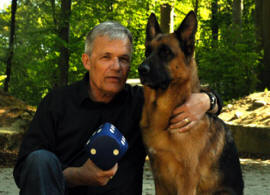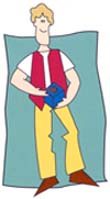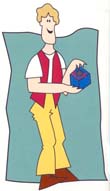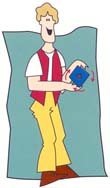
![]()
by the inventor
Kurt Lind Joergensen

Your
dog
needs to be mentally
stimulated
Many of our dogs do not get the opportunity to use their natural instinct for mental exercise. Mental stimulation not only provides a fuller life for our dogs but it is also vital in the prevention of many behavioral problems. A contented dog usually means a happier owner. Dog psychologists have demonstrated that many behavioral problems can be reduced by mental stimulation.
Your dog
imitates
you
Most dogs now live solely as our companions and few are offered the opportunity to carry out the tasks of hunting that their breeds were originally developed for. While we love our dogs enormously, many do not receive enough mental stimulation to compensate for this. In the wild, dogs live and hunt in packs. Each member of the pack has to work as part of a team when hunting for food. Our domesticated dog is still basically a pack animal and quickly adopts his owners as pack members, usually as pack leaders. This means that from puppyhood they learn to imitate the behavior of the family, i.e. your dog’s human “pack”, following us around the house and learning how to communicate with us.
But indoor activities are not that interesting, and the bored dog may lie down in one particular spot from where he can watch us in the hope that I something exiting might happen such as feeding time, play time or going for a walk. These are often the most exciting events in a dog’s life. The more a dog rests and watches, the more pent up energy he has. If this energy is not used, it can result in various behavioral disorders such as chewing shoes and furnishings. Owners often ignore the dog or encourage him to sleep more so that he is less destructive, but this just leads to more unspent energy and a bored, lazy dog. Such a naturally active animal then has to adjust his behavior to the circumstances and your relationship becomes far less rewarding. A little mental stimulation can go a long way to improving your dog’s quality of life and the value of your relationship!
The wolves.
Dogs are descended from wolves. Just like wolves, dogs are pack animals in which unity and co-ordination of activity are vital. Wild dog packs and wolf packs cannot afford too much individual activity as it would cause one animal to be tired while the rest of the pack rest, and thus the balance of the pack’s social and hunting life can be disrupted. Pack animals need to rest and be active together.
After the puppy stage
the dog becomes more and more passive, and excitable, experimental
activities are initiated by his “leader”, i.e. the owner/family. When
the “leader” is resting, so should the rest of the pack. When the
“leader” is active, so are the others and this pattern continues even
after 10,000 years of domestication. As soon as the owner is active, the
dog is active too, perhaps following the owner from room to room,
waiting for co-ordinated activity. However, as your dog gets older he
finds that indoor activities are not very interesting and waits until he
is allowed outside to “let off Steam”. As the dog is now sleeping most
of the day, his accumulated energy might cause him to become
over-energetic and hyperactive when given the chance, or in response to
minor activities at home. This increases the risk of him becoming a
nuisance.
Don’t let your dog
rest too much
Studies show that there is a connection between behavioral problems and too much rest and boredom.
In 1985 the Swedish dog psychologists Anders Hallgren and Marie Hansson Hallgren made a study of dog behavior. 329 dog owners were asked just how active their dogs were, how much walking and other outdoor activities they enjoyed, and also how active their dogs were indoors. Owners of dogs with behavioral problems were asked to describe the nature and severity of these problems.
Results:
The most passive dogs
Half of the dogs surveyed spent more than 20 hours a day resting and inactive. 77% of the dogs in this group had behavioral problems, most of them severe according to the owners.
The “in-between” dogs
35% of the dogs in this group were resting and inactive 18-20 hours a day. Almost 70% of these dogs had behavioral problems, half of which were classified as severe.
The most active dogs
12.5% of the dogs surveyed were resting and inactive maximum 18 hours a day. Approximately 50% of these dogs showed behavioral problems, a third of which were described as severe by the owners.
This study therefore showed that many of our dogs are simply not stimulated enough and this contributes significantly to the development of behavioral disorders.
.jpg)
Mental
exercise
As you can see, your dog needs to be stimulated and depends on your initiative for this.
Indeed, studies of wild dogs’ activities show that physical activity is less taxing than mental activity. For example, if you compare the tiredness of your dog after a day of long walks to the happy tiredness he shows after spending the day with other dogs at dog shows or after training, you will know that he is far more exhausted after the show or training classes even though he has had less physical exercise.
Therefore in addition to physical exercise we should offer our dogs the mental exercise and stimulation which we may be depriving him of.
By serving your dog ready-to-eat meals we have unwittingly eliminated one of his basic activities, hunting and foraging for food. These are activities in which the dog would have to use his natural instincts to find the food, work out how to catch it, etc. This sort of mental exercise is very important and your dog will be a happier and more contented individual if you can provide it in other forms. You will also in other forms. You will also help to prevent many common behavioral problems from developing in your dog. And, if you already have such problems, you might even be able to decrease their severity or eliminate them completely.
Three kinds of
activities
All dogs are mentally stimulated when tracking and hunting prey, and solving the problems of difficult terrain and changing surroundings that they encounter along the way. Dog psychologists Anders Hallgren and Marie Hansson Hallgren have investigated this, and have identified three very important features of this activity:
1. Sense of smell
All dogs have an extremely well developed sense of smell, which is a million times better than ours, and they love using their nose to track and hunt. This provides a great deal of mental stimulation.
2. Problem solving
Problem solving demands much concentration. When faced with a problem, dogs often have to sort things out for themselves. They enjoy this kind of challenge, and you can help your dog to develop and find happiness by giving him problems to solve to gain rewards.
3. Learning
Dogs enjoy learning new behavior that leads to rewards, and you can teach your dog not only the basic things such as “sit” and “heel”, but more complicated “tricks” such as fetching your slippers or their lead. Some dogs can be taught to open and close doors or, like the guide dogs for the blind or hearing dogs for the deaf, perform highly complicated behaviors to our benefit. Training is about shaping behaviors for the prospects of rewards - the best ones are food and your love and approval.
Buster Cube
Stimulates your dog
I been working with dogs and treating their behavioral problems for lot of years, so this incident was the occasion to, I developed the Buster Cube.
Buster Cube is a simple interactive toy for stimulating your dog mentally, and to help him to concentrate and use up excess energy. All you need to do is to start the game - the dog will do the rest with the Buster Cube. Your dog can exercise itself.
Buster Cube can be used for all dogs of all sizes. Small dogs have proved that solving the puzzle of the Cube is more a question of cleverness and agility rather than strength.
Supervise your dog
A dog will naturally use his teeth to crush things that might be edible, eg. bones to get to the bone marrow. Initially he may try to bite the Cube to get to the food at the centre, so when you first introduce the Cube to your dog, you should supervise your dog’s play and gently interrupt him if he tries to bite it.
After a few experiments he will soon learn that it is easier to get to the food by rolling the Cube with his nose and paws rather than trying to bite it!
What to do if your
dog
shows little interest in the
Buster Cube
Dogs are wise enough not to put effort into things which are unnecessary. Why hunt for food” if there always is plenty in the dish?
You may have to teach your dog how to play with the Buster Cube and easy instructions can be found below.
If your dog does not want to play with the Cube, it might be a sign that he is unwell. If you suspect that the lack of interest could be caused by healthy problems, please consult your veterinarian.
But it may also be that he needs more encouragement at the start from you, perhaps on a different surface. If he is generally unreactive and disinterested, he may need a broader program of physical and mental stimulation before the Cube becomes important to him. You may like to divide his meals into frequent short feeds so that mild hunger will stimulate him into greater activity and interest m the Cube.
You might wish to seek the help of a dog behaviorist for further advice.
The fact that some dogs are reluctant to face new challenges can often be explained by our habit of solving all their problems for them, resulting in “helpless”, disinterested dogs.
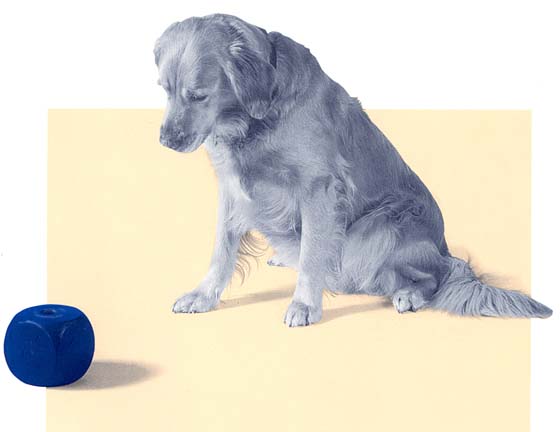
Buster Cube
is easy to use
|
Put a tablespoonful of dry food into Buster Cube through the opening.
Turn the central cylinder in the Buster Cube to adjust the level of difficulty. Place it on the floor for the dog with the hole upside |
Buster Cube is divided into several compartments which release the food pellets when the dog rolls the Cube with his nose or paws. The smaller the food pellet, the more pellets it takes before your dog feels full and the more energy he will use getting enough food out of the Cube.
Also, because it is important that your dog does not become overweight, his daily food allowance should be reduced to an amount of food equal to what he eats when playing with the Cube.
Turning the cylinder towards min. or max. regulates how easily the food will be released, and is a way of adjusting the level of difficulty for your dog as he progresses. Enthusiastic Buster Cube-players need a greater challenge!
Buster Cube will withstand ordinary cleaning agents and is dishwasher safe. Avoid cleaning agents containing mineral solvents.
For ease of cleaning remove the central cylinder. When replacing it, make sure that it fits correctly into the opening of the Cube. When correctly assembled the cylinder should turn between min. and max. only. |
Turn the Buster Cube to distribute the food into the various compartments inside. |
